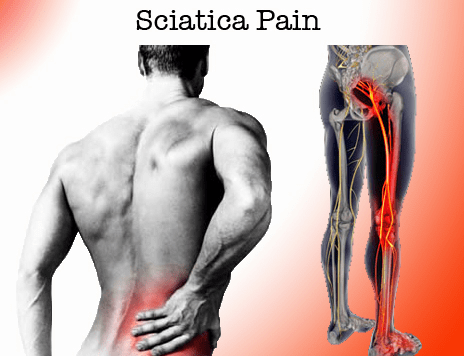- 02 9712 1736
- [email protected]
- 212 Great North Road, Five Dock, NSW 2046
- Open 7 days a week
Sciatica is a term often used to describe sciatic nerve pain. It refers to pain that radiates along the path of the sciatic nerve. Pain is often felt in the lower back, buttocks, back of the leg, and may reach the foot or toes.
Pain is described as a sharp, shooting pain that is burning in nature. Usually starting off as back pain, it is later accompanied by development of numbness, tingling, pins-and-needles sensation in the affected leg. Some people also experience muscle weakness in the leg or foot which results in clumsiness when walking. Symptoms of sciatica may worsen with movement, prolonged sitting, or coughing.

Sciatica is pain resulting from compression of the sciatic nerve. Symptoms associated with sciatica are therefore similar to symptoms caused by pinched nerves. Compression can occur along the length of the sciatic nerve or at the level of the spinal cord, nerve roots, or spinal nerves before they form the sciatic nerve.
Compression may be a result of lumbar spinal stenosis or the narrowing of the spinal canal in the lumbar spine as a result of herniated discs associated with degenerative disc disease and arthritis-related changes such as development of bone spurs. In rare cases, it may be a result of a growing tumour, inflammation from a fracture in the lumbar spine, or an infection.

Compression can also occur at the sciatic nerve as it passes through the piriformis muscle in the buttocks, which results in piriformis syndrome.
Some medical conditions present with other symptoms on top of sciatica symptoms mentioned above and is in fact not a result of compression of the sciatic nerve. If you are also experiencing severe pain, difficulty with bowel or bladder control, and you are experiencing numbness in the inner thigh and groin area on top of the common symptom of back pain, you may have cauda equina syndrome and require immediate medical attention.
Unlike sciatica, cauda equina syndrome is a result of compression of the nerve bundle at the base of the spine, and may result in permanent nerve damage and loss of function if not treated quickly.
The sciatic nerve is the widest and longest nerve in the human body. Spinal nerves emerging from the lumbar spine and sacrum unite together to form the sciatic nerve which passes beneath the piriformis muscle and into the posterior thigh.

While anyone can develop sciatica, there are several factors that can increase these chances. Common risk factors associated with sciatica and back pain include increased age, reduced activity level, sedentary lifestyle, obesity, pregnancy, and occupation which requires prolonged sitting, exposure to vibrations, repetitive twisting, or heavy lifting.
In order to diagnose sciatica, your primary care provider will require a complete medical history and perform a physical and neurological examination. Your medical history and the result of your physical examination will help narrow down possible diagnosis and ensure that you are provided with the appropriate treatment.
You may also be referred for imaging tests such as an MRI scan in order to gain a better understanding of what is causing sciatica like pain. Imaging tests will reveal presence of herniated disks or other space occupying lesions resulting in spinal stenosis or compression of the spinal cord and nerve roots.
In keeping with best practice back pain care. Sciatica treated with conservative treatment is usually the first recommendation. Physical therapy and massage therapy may be used in combination with exercise recommendations in order to improve mobility and musculoskeletal function, as well as to improve strength of the core and back muscles. Other treatments including alternative therapies such as acupuncture may also be used to relieve pain and promote healing.
Your primary care provider may recommend taking over-the-counter anti-inflammatory medications or provide you with prescription medications such as muscle relaxants to help reduce pain while you seek other treatment options to address what is creating compression of your sciatic nerve, for instance a herniated disc. Steroid injections may also be offered to reduce inflammation and therefore reduce pain.
In the case where severe pain persists despite conservative treatment and a clear structural problem can be identifies, such as a herniated disk, surgical procedure may be performed.

Steroid injections are administered to reduce inflammation which could help to decrease compression to the sciatic nerve and decrease pain. The effect of steroid injections may wear away after a few weeks however and you may start experiencing back pain again. Steroid injections often may be administered to decrease pain enough to allow conservative treatment or alternative therapies to take place.
Maintaining proper posture when you are sitting can help reduce compression and compromise of the neuromusculoskeletal structures of your back and improve back pain in general. Having poor posture habitually while sitting may create reduction of space and mobility in the lumbosacral spine which may in turn develop into back pain and sciatica.
If you have chronic sciatica and are dealing with chronic pain, at home self care treatments may be beneficial to maintain mobility and flexibility of your spine. At home self care treatments aim to maintain low levels of pain and inflammation and include heat therapy, gentle stretching and exercise routine. Self care measures alone however may not be enough in the case of acute pain due to acute sciatica. It is important to consult a healthcare professional for proper diagnosis and treatment plan, so that it does not develop into chronic sciatica and long term repetitive back pain.

In cases where permanent loss of function and muscle weakness due to neurological injury is a possibility, such as in the case of cauda equina syndrome, surgery will need to be performed. If you are experiencing unrelenting severe pain accompanied with progressive loss of neurological functions, surgery will be considered.
Use of surgery to treat sciatica depends on the underlying cause of nerve compression. In cases where sciatica is caused by an identifiable structural problem, such as a herniated disk, a surgical procedure, in this case a discectomy, may be done to remove the nerve compression. Physical therapy may be necessary following surgery to rehabilitate musculoskeletal function and movement.
Physical therapy in combination with massage therapy and the prescription of an exercise program may be used to treat sciatica pain by improving mobility and musculoskeletal function, as well as improving strength of the core and back muscles. In certain cases, physical therapy may be enough to reduce compression of the sciatic nerve and resolve sciatica pain. You will also be provided with self care measures that you can do at home following treatment to maintain mobility, improvements in pain level and inflammation following treatment.

Sciatica is a deliberating condition that can affect all ages.
Sciatica present as pain from your lower back, which radiates down your leg along the length of the affected nerve. It may present with numbness, pins and needles or a burning sensation. In cases where the pain is not addressed, you may also experience leg weakness or foot drop.
It is important from a young age to be mindful of the long-term side effects of our actions. Degenerative disc or joint disease is a leading cause of sciatica pain in the patient we treat. This is often the result of deconditioning due to the underuse of the muscles which protect your spine.
It is important throughout your life to maintain your muscle strength and control of your spinal muscles. This decreases the risk of sciatica by ensuring your muscles are doing the work and not your joints or spinal discs.
If you are experiencing sciatica, the good news is that treatment options are available.
Treatment for sciatica will begin with physical therapy to alleviate your presenting pain, improve your postural control and retrain how you are moving to prevent further injury. If physical therapy does not alleviate all your symptoms, you may require surgery.
Surgery will take pressure off your sciatic nerve. However, remember it is important post-surgery to participate in an active rehabilitation plan to maintain the results and prevent a regress in symptoms.
If you are looking for conservative treatment for sciatica in Sydney or need a rehabilitation plan. Feel free to get in touch with us! We’re always here to help and would love to hear from you.



About
Five Dock Osteopathic & Chiropractic is located in Canada Bay, in Sydney’s Inner West. Servicing suburbs including Burwood, Croydon, Drummoyne, Five Dock, Haberfield, Concord, Abbotsford, Chiswick, Leichhardt, Wareemba, Russell Lea, Summer Hill, Strathfield.
Clinic hours
Monday, Tuesday, Thursday 7AM – 7PM
Wednesday, Friday 7AM – 6PM
Saturday 7AM – 2PM
Sunday 8AM – 2PM
Contact details